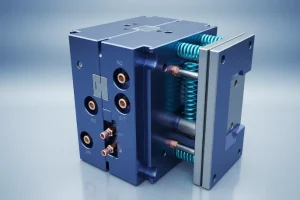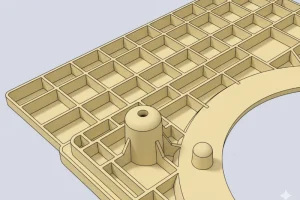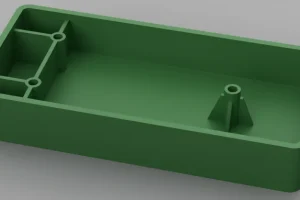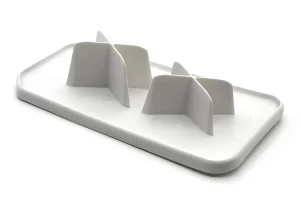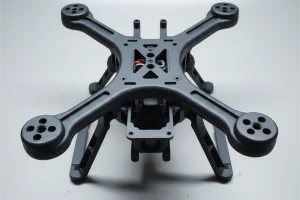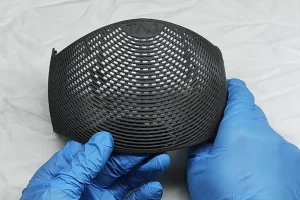Nowadays, plastic injection molding is one of the most popular ways to manufacture a wide variety of plastic products. From tiny products to big, complicated parts, injection molding has the precision, efficiency, and consistency to serve a wide range of industries effectively. One of the important decisions a company will have to make when choosing plastic injection molding for a project is low or high-volume production. Each approach has its strengths, weaknesses, and areas of use, which we will discuss in the following sections. In this blog post, we will discuss the difference between low volume and high volume plastic injection molding and what you need to know to choose the right manufacturer for your company.

Understanding Plastic Injection Molding
Plastic injection molding is done by injecting molten plastic into a mold cavity and letting it cool and solidify.
1. Clamping: The mold is closed tightly by the clamping unit.
2. Injection: Molten plastic is pushed into the mold cavity through an injection point.
3. Cooling: The plastic cools and solidifies inside the mold.
4. Ejection: The finished product is pushed out of the mold.
This method is great for making lots of the same parts that are all the same size. But remember, the ideas and steps are the same whether you’re making a few parts or a lot of parts.

Low-Volume Plastic Injection Molding
Conventional or standard low volume plastic injection moulding is a process whereby few injections of plastic moulds are produced thereby manufacturing a limited number of parts, say from fifty to two thousand parts. This is a popular approach when constructing prototypes, running pilot production, manufacturing special orders, and executing small-batch production.
Advantages of Low-Volume Production
1. Flexibility: When it comes to print quantity, you can make more design changes and refinements. Even if you have to make changes to accommodate new requirements, you can do so without spending a lot of money.
2. Reduced Tooling Costs: Low volume manufacturing costs are typically much lower, initial tooling outlay notably so. This makes it a great place for new startups, small-scale businesses, and companies that are launching new products.

3. Faster Time to Market: This is because the tools required are basic and inexpensive compared to the complex ones that take much longer to produce, reducing the overall time to bring new products to market.
4. Customization: Low volume production is often ideal when you’re making small quantities of a product or products that are unique or different from what’s being made in large quantities.
5. Risk Mitigation: One of the advantages of low volume manufacturing is that it reduces the cost associated with the risks of new products by allowing you to test them in the market before making them on a large scale.

Challenges of Low-Volume Production
1. Higher Per-Unit Costs: When you make fewer parts, the cost of each one goes up because you have to spread the cost of tooling and setup over fewer parts.
2. Limited Economies of Scale: But because machines and other equipment are expensive, low volume production can be a lot more expensive than high volume production, making it less attractive for big projects.
3. Capacity Constraints: Most suppliers have limited capacity or don’t want to do low volume production, so your options are limited.

High-Volume Plastic Injection Molding
When a company wants to make a lot of parts, like tens of thousands or millions, they use this type of plastic injection molding. This is for products that are used a lot and need to be made over and over again.
Advantages of High-Volume Production
1. Lower Costs Per Unit: This means that when you produce a lot of something, the cost of each one goes down because you can take advantage of economies of scale and use your materials and equipment more efficiently.
2. Consistent Quality: This means that you can make the same thing over and over again, which is important if you’re making a lot of the same thing and you need them all to be the same.

3. Efficiency: This means that you can use really fancy machines and tools to make a lot of something really fast.
4. Supplier Availability: This means that if you’re used to making a lot of something, you have a lot of choices for where you get your stuff and where you send your stuff to get made.
5. Long-Term Supply: This means that if you’re making a lot of something, you can keep making it, which is important if you’re making a lot of something and you need to keep making it.

Challenges of High-Volume Production
1. High Initial Investment: The biggest downside to 3D printing is the cost to get started, including the equipment and setup expenses.
2. Inflexibility: It’s hard to make big changes and improvements to your design because you’re locked into the size of your printer and the systems you’ve already set up.
3. Longer Lead Times for Tooling: If you’re making a lot of something, you have to wait for the molds to be made and optimized before you can start production, which can slow you down.
4. Inventory Management: When you make things, you have to build a supply chain to get parts and store inventory, which can be a challenge.
5. Market Risk: If you buy a bunch of factory capacity without knowing if the market wants your product, you can end up flooding the market and getting stuck with a bunch of inventory if the market doesn’t respond.

Application
Applications of Low-Volume Plastic Injection Molding
Low-volume plastic injection molding is widely used across various industries for specific applications:
1. Prototyping and Product Development: This is ideal in creating initial sample models as well as practical models for testing and analysing the design, use and also the reception from the targeted consumers.
2. Pilot Runs: Ideal for the first test production for the manufacturing company because it allows testing of manufacturing processes as well as collection of performance data before going to full-batch production.

3. Custom and Specialty Parts: Beneficial for running highly concentrated pieces that are produced to suit a particular trade or are used in some kind of process such as medical or commercial.
4. Small Batch Production: Utilized each time that products are produced in small quantities, that is for specialized specific markets, or for products of which the demand is low.
5. Bridge Manufacturing: It is employed in circumstances where there is need to transition from prototyping to production to reduce risks and hazards.

Applications of High-Volume Plastic Injection Molding
High-volume plastic injection molding is crucial for mass production in a variety of industries:High-volume plastic injection molding is crucial for mass production in a variety of industries:
1. Consumer Goods: High-volume plastic injection molding is in charge of generating diverse products, including household appliances, computers, communications equipment, etc. They have to be affordable and of high quality.
2. Automotive: Mostly applied in the automotive industry to manufacture small, complex pieces and parts of cars like car interiors, the dashboard or panels, and other internal automotive elements beneath car hoods.

3. Medical Devices: Frequently criticised for not being able to stick to highly tolerances and cannot easily be adapted to meet the quality and/orlegal standards that are needed for manufacturing medical devices and components of medical devices.
4. Packaging: It is chiefly widely utilized in packaging industries such as bottles, containers, caps, closures, and other manufactured goods in a big way.
5. Industrial Applications: Which served to make other elements and pieces which are applied in other industries which need the parts to be extremely tough and accurate.

Key Considerations in Choosing Between Low and High Volume
When deciding between low and high-volume plastic injection molding, several critical factors must be considered:
1. Product Life Cycle: It’s important to understand the product life cycle. In the case of a new product or a product that’s still being tested, low-volume production is the best way to get feedback on how the market likes it and make any necessary design changes. In general, if you have a product that’s selling well, you’re better off making a lot of them.
2. Budget and Financial Constraints: This means that how much money you have to spend on tooling and production will be a big factor in deciding which concept to go with. Low volume production uses less fancy tooling, so it costs less up front. This is great for startups or small companies. High volume production is better in a lot of ways, especially in the long run, but it costs more up front.

3. Time to Market: In today’s world, people are increasingly facing stiff competition and thus, speed is of the essence. The increased volume of production is achieved by breaking larger and more complex orders into smaller and more manageable tasks. In the long-run, it will secure a full production line that will economically support a high-online service that has a slow initial response time.
4. Quality and Consistency: Injection molding manufacturers point out that industries requiring precise tolerances, such as automotive, aerospace, and medical industries, prefer volume production because it is more uniform and accurate. On the other hand, while advantageous in terms of flexibility, high-quality production at high volumes can require strict quality assurance measures.

5. Customization and Complexity: Low volume production is the way to go when the part is custom designed and developed for a specific use in a specific application or when the part is one-of-a-kind and not used in the same form in another production process very often. Complex geometry and a large number of features are not good for high volume production because the parts would have to have very small variations.
6. Supplier Capabilities: Supplier factors play a big role in this. The more the setup, abilities, and skills the suppliers have, the better. Some suppliers have figured out how to handle making small lots or big lots, or both. Evaluating the strength and weakness of the supplier helps you pick the best supplier for your project.

Advancements in Plastic Injection Molding Technology
Plastic injection molding is still the most booming industry with technological advancements that have improved both low and high volume production.
1. Automation and Robotics: Automation and robotics in injection molding have the benefit of increasing efficiency, precision, and reliability in producing a good product. They help to minimize the human factor in production, increase production rate, and cut labor costs, which is good for both small and large scale production processes.

2. Advanced Materials: The types of plastic and what they can do keep changing because new plastics, high-performance plastics, and hybrid plastics for injection molding keep coming out. These plastics have better mechanical and chemical properties, and they can handle different environments. That’s why different industries use them.
3. Additive Manufacturing: Injection molding is a manufacturing technique that requires 3D printing to work alongside it because it is perfect for prototyping and low volume production of complex parts. It gives you the flexibility of rapid prototyping and initially cuts down on the time and the costs associated with tooling.

4. IoT and Industry 4.0: Most manufacturing companies have adopted the use of IoT (Internet of Things) and Industry 4.0. It helps in monitoring the process, operation and improving the process related to it. Smart manufacturing systems form a closed-loop system, collecting data and analyzing it in real-time, thus improving quality control, predicting breakdowns.
5. Sustainable Practices: Sustainability is becoming more and more important in the injection molding industry. There are several ways that manufacturers are trying to reduce the impact of non-biodegradable plastics, including using recycled plastics, using biodegradable plastics, and being more energy efficient.

Future Trends: Small-Batch Injection Molding: On-Demand Manufacturing Becomes the Next Industry Trend
One big thing that’s happening in rapid manufacturing is that it’s going through a big change. This fast-moving market has the added pressure of getting products to market as fast as possible. Plus, designers, engineers, and manufacturers have to make sure they’re making good products. Low-volume injection molding is a manufacturing technique that addresses customer needs too. It lets manufacturers make small batches of parts that are similar to each other in terms of the properties and qualities of the plastics. Manufacturers are starting to use new ways of doing things to stay competitive in the market.

On-demand low-volume manufacturing is a concept that seems to have recently joined the manufacturing mainstream. It has many implications and has clearly changed the dynamics of the relationship between engineers and suppliers or manufacturers. In traditional manufacturing, you make many similar products at the same time and in a repetitive manner. On the other hand, on-demand manufacturing is about low-quantity, high-variety products, which are common in small plastic injection molding. It is based on the use of cloud computing technology, and users serve themselves. It also allows the customers to get the quotes as soon as they are made, and track the progress of their orders in the manufacturing process.

With on-demand manufacturing, customers can order precision low-volume injection molded parts only when they need them. Purchase volumes will smoothly match just-in-time manufacturing. It will help address several concerns including lead time, communication, DFM and cost. As digital technology continues to advance in the industry, on-demand manufacturing is leading the way in acceptability.
Conclusion
Choosing between low and high volume plastic injection molding depends on a few factors such as; The life-cycle of the product, the cost of production, the time to market, quality standard, and the extent of customization. Each of the fits has benefits and potential issues and thus must depend on the particular project and its objectives.

These have low production rates, and require less capital to start, shorter time to complete, best for short-run manufacturing, and part runs. Volume production is inexpensive, it improves product quality, and can be easily scaled up, making it good for products that have a stable market.
Plastic injection molding is still a big deal in manufacturing and it keeps getting better with new technology for both low and high production. But by understanding the differences in each approach and using technology, you can make the right decisions in the right manufacturing environment and meet your business goals.


